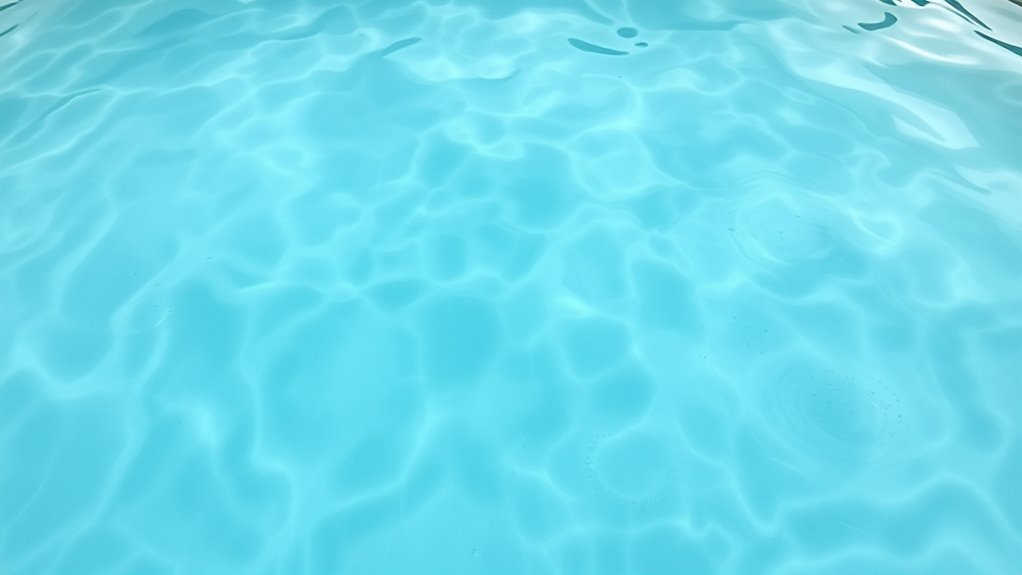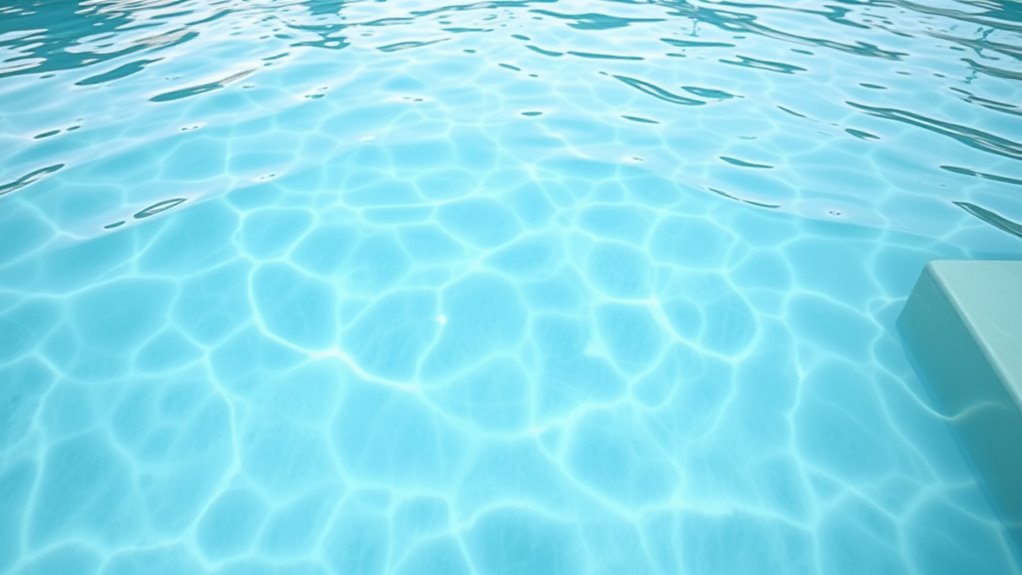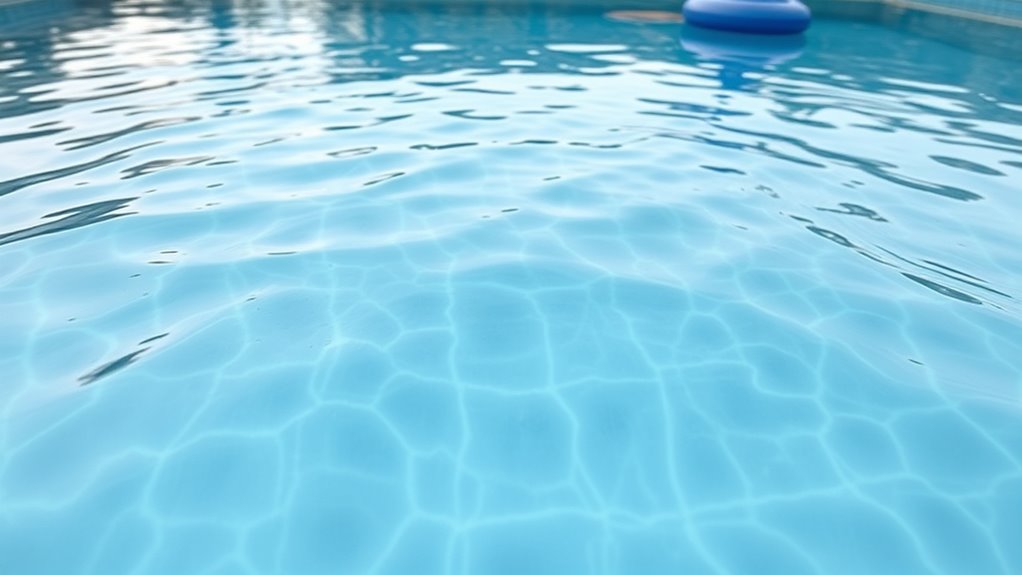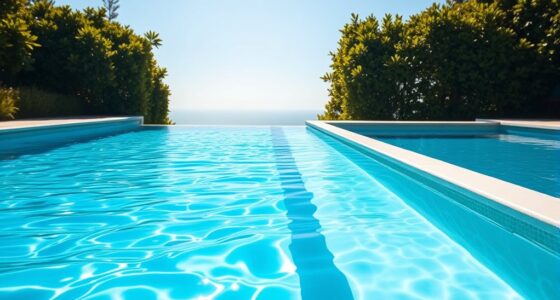Cloudy pool water often results from chemical imbalances, biological contamination, or filtration issues. High pH or alkalinity can cause scale and cloudiness, while dirt, algae, or bacteria can cloud the water despite filtration. Mineral deposits or metal contamination also play a role. Regularly testing and adjusting your pH, alkalinity, and chlorine levels, plus maintaining your filter and removing debris, helps clear up the water. Keep exploring to learn more ways to restore your pool’s clarity.
Key Takeaways
- Chemical imbalance, especially improper pH and alkalinity levels, can cause cloudiness and scaling.
- Bacterial growth, algae, and microbes thrive at higher temperatures, leading to cloudy, contaminated water.
- Poor filtration, clogged filters, or insufficient circulation allow debris and particles to remain suspended.
- Metal contaminants and minerals can discolor water and create cloudiness if not properly tested and treated.
- Regular testing, proper chemical adjustments, and routine maintenance are essential to prevent and clear cloudy water.
Understanding Water Chemistry Imbalances

Understanding water chemistry imbalances is essential for maintaining clear and healthy pool water. When pH levels drift outside the ideal 7.2 to 7.6 range, chlorine becomes less effective, leading to cloudy water and potential skin or eye irritation. High pH (above 7.6) reduces chlorine’s disinfecting power and causes scaling, while low pH (below 7.2) can corrode pool surfaces and equipment. Alkaline substances like baking soda can raise pH, requiring careful adjustments with muriatic acid or pH decreasers. Total alkalinity, ideally between 80 and 120 ppm, stabilizes pH, but too low causes acidity, and too high promotes cloudiness and scaling. Regular testing and precise chemical adjustments help keep your water balanced, preventing cloudiness caused by chemical interactions. Maintaining proper pH levels is also crucial for preventing calcium carbonate precipitation, which can lead to cloudy water and scaling. Proper water testing ensures you can accurately monitor and adjust chemical levels, keeping your pool water clear and safe.
Identifying Biological Contamination in Your Pool

You can spot biological contamination by noticing signs like slimy surfaces, foul odors, or unusual cloudiness, which often point to microbial growth. Rising temperatures can accelerate pathogen multiplication, making it more urgent to test and clean your pool. Regular disinfection and monitoring help catch issues early before they turn into health risks. Monitoring water quality is essential to ensure that microbial levels stay safe and within health standards. Using appropriate air purifier technology can also help improve indoor air quality, reducing the risk of airborne contaminants that may affect pool environments.
Signs of Microbial Growth
Cloudy water is one of the most obvious signs that your pool may have microbial growth. If your water appears murky despite filtering, it could indicate bacteria, algae, or other contaminants thriving. Look for changes in water color, such as green, yellow, or black patches, which often signal algae growth. Foamy or oily films on the surface suggest organic buildup that supports microbes. Swimmers experiencing persistent skin, eye, or throat irritation may be exposed to contaminated water. Additionally, a strong or unusual chlorine smell can mean chloramines are forming, indicating organic matter and microbes reacting with disinfectants. These signs point to microbial presence, and addressing them promptly helps ensure your pool remains safe and healthy for swimmers. Regular testing of water quality is essential to detect and correct issues early before they become more serious problems. Maintaining proper water chemistry can help prevent microbial growth and keep your pool clear.
Impact of Temperature Rise
Have you ever noticed how warm water can quickly lead to increased microbial activity in your pool? When temperatures reach 81°F or higher, chlorine breaks down faster, lowering its disinfecting power. This means you’ll need to add chlorine more often to keep bacteria and algae at bay. Warmer water also raises the pH, reducing chlorine’s effectiveness and creating ideal conditions for pathogens like Pseudomonas aeruginosa and Cryptosporidium to thrive. Elevated temperatures double the risk of parasitic contamination and other infections. Plus, heat causes evaporation, concentrating minerals and leading to cloudiness. Heavy bather loads and prolonged pool hours further increase contamination risks. To prevent biological growth, it’s essential to monitor chlorine levels, adjust chemical balance, and maintain proper filtration during hot weather. Proper chemical management is crucial to prevent rapid microbial growth and ensure the water remains safe and clear. Additionally, understanding how water temperature influences biological activity can help you take preventative steps effectively.
Effective Disinfection Strategies
Identifying biological contamination in your pool is essential for maintaining a safe swimming environment. When you notice cloudiness, off-smells, or slime films, it could signal a contamination issue. To effectively disinfect, focus on these strategies:
- Maintain free chlorine at 1 ppm for pools and 3 ppm for hot tubs to kill microbes efficiently.
- Keep pH levels between 7.2 and 7.8, ensuring chlorine works ideally.
- Use shock chlorination after fecal incidents or vomiting to rapidly reduce pathogens.
- Routine testing of disinfectant levels and water quality helps catch problems early. Incorporating secondary disinfection methods like UV or ozone can also improve pathogen inactivation, especially for chlorine-resistant parasites such as Cryptosporidium. Proper disinfection safeguards swimmers and keeps your pool clear. Additionally, understanding Honda Tuning can provide insights into how engine performance modifications can influence vehicle operation, similar to how proper chemical balance affects pool health.
Recognizing Filtration and Circulation Problems

To keep your pool water clear, you need to regularly check your filter and circulation system for signs of trouble. Make sure your filter media is clean and functioning properly, and inspect the flow and pressure to spot issues early. Proper jet placement also helps guarantee even water movement and prevents stagnation that can cause cloudiness. Decreased Water Flow can be caused by clogged or damaged filters, which struggle to circulate water effectively, leading to debris buildup and poor filtration. Additionally, a malfunctioning sneaker technology system may contribute to inefficient circulation if it affects the pump’s performance.
Filter Maintenance Checks
Regularly checking your pool’s filter and circulation system is essential to maintaining clear water. To do this effectively, monitor these key aspects:
- Pressure gauge readings: Look for a rise of 5–10 psi above the baseline, indicating it’s time to clean or backwash.
- Visual inspection: Check for debris buildup or blockages in the filter area, including cartridges or sand beds.
- Water flow: Ensure return jets are strong and consistent; weak flow suggests a filter restriction or debris clog.
- Filtration system efficiency: Regular assessments help identify potential filter performance issues before they cause more significant problems.
If you notice high pressure, slow flow, or cloudy water, it’s time for a maintenance check. Regular inspections help prevent filtration issues, reduce strain on equipment, and keep your water crystal clear.
Circulation System Inspection
Are you aware of the key signs that indicate your pool’s circulation system isn’t functioning properly? You might notice visible leaks in pipes, valves, or connections, which reduce water flow and filtration efficiency. Air in the pump or irregular noises could signal suction-side leaks or improper priming, disrupting circulation. Check if all valves are correctly positioned; incorrect settings can bypass filtration. Clogs in skimmer baskets, pump strainers, or pipes also restrict flow. Low pump pressure suggests blockages or leaks, while weak return jet flow points to circulation issues. Frequent cycling or failure to prime indicates air leaks or pump malfunction. Excessive noise, vibration, or insufficient run time further highlight problems, all of which can contribute to cloudy water and poor pool clarity. Proper maintenance of your circulation system is essential to prevent these issues and keep your water clear.
Proper Jet Placement
Proper jet placement is essential for maintaining effective circulation and preventing filtration problems in your pool. Correct positioning helps create a vortex that pulls debris toward skimmers and distributes filtered water evenly. To optimize flow:
- Angle jets slightly downward to promote bottom-to-top circulation.
- Aim all jets in the same direction for a consistent vortex.
- For pools with multiple jets, direct them at about 45 degrees toward the bottom in unison.
Shallow end jets should point upward and toward the skimmer to help surface debris collection. Proper placement reduces dead zones, improves filtration, and keeps water clearer. Regularly check and adjust jets to ensure they remain aligned, especially if you notice poor circulation or persistent cloudiness. Proper jet placement helps maintain balanced water chemistry and prevents cloudiness caused by stagnant areas. Additionally, ensuring proper jet positioning enhances water flow efficiency, which is critical for overall pool health. Proper jet positioning is key to a healthy, clear pool.
Detecting Mineral and Metal Contamination

Detecting mineral and metal contamination in your pool is essential for maintaining clear, healthy water. Metal presence can cause discoloration, stains, and persistent cloudiness. To identify contamination, use test kits specifically designed for metals, as standard test strips may not be accurate enough. Liquid reagent kits offer more precise results, while professional testing services provide extensive analysis. Digital testers can track multiple metals over time. Regular testing helps catch early signs of contamination before major issues develop. Additionally, understanding the sources of metal contamination, such as corroded equipment or environmental factors, can help prevent future problems.
Adjusting Chemical Levels to Improve Clarity

Maintaining clear pool water depends heavily on balancing chemical levels correctly. Proper adjustments help eliminate cloudiness caused by imbalanced sanitizers, pH, or alkalinity. First, guarantee free chlorine stays between 1–3 ppm; shock treatments can rapidly restore clarity after heavy use or cloudiness. Second, keep pH within 7.4–7.6, adjusting gradually with pH increasers or decreasers and retesting after several hours. Third, monitor total alkalinity to stay between 80–120 ppm, as it buffers pH fluctuations; adjusting alkalinity first stabilizes other levels. Regular testing and incremental chemical adjustments prevent sudden swings that cause cloudiness. Consistent testing and careful chemical adjustments are essential to prevent water cloudiness and maintain an inviting pool. Additionally, understanding water chemistry helps in diagnosing and correcting issues more effectively. By following these steps, you maintain ideal water chemistry, ensuring your pool stays clear and inviting.
Enhancing Filtration and Maintenance Routines

Have you guaranteed your pool’s filtration system runs long enough to keep water crystal clear? Running it for at least 8 hours daily ensures debris and contaminants are effectively removed. During hot weather or heavy use, extend runtime to maintain clarity. Keep an eye on the pressure gauge; a rise of 8-10 psi indicates the filter needs cleaning or backwashing. Regularly backwash sand filters and rinse cartridge filters every 4-6 weeks, replacing cartridges every 1-2 years. DE filters require backwashing at 20% pressure increase and replenishing DE powder afterward. Inspect filters for damage and replace media when needed. Proper circulation is essential—aim jets downward and away from the skimmer, and clear obstructions to prevent stagnation. Maintaining these routines keeps your water clear and healthy. Regular filter inspections also help identify early signs of wear or damage, preventing costly repairs and ensuring optimal performance. To optimize your pool’s filtration, understanding filter media and its maintenance needs is crucial for long-term clarity.
Managing Environmental Factors and Organic Debris

Environmental factors and organic debris play a significant role in causing water cloudiness, even when your filtration system is running ideally. Leaves, pollen, dirt, and dust from nearby trees and wind introduce suspended particles that make water murky. Seasonal changes, especially spring and fall, increase pollen and debris levels. Bird droppings and runoff water add organic matter and microorganisms that degrade clarity. Wind accelerates debris entry, while landscaping or construction deposits fine dirt into the pool. To manage these issues effectively: 1. Regularly skim debris from the surface to remove floating particles. 2. Use a pool cover when not in use to prevent debris accumulation. 3. Install barriers or landscaping buffers to reduce wind-driven debris entry. Maintaining proper chemical balance also helps prevent organic buildup and keeps your water clear. Additionally, regular water testing can help identify imbalances before they contribute to cloudiness. These steps help keep your water clear by minimizing environmental contaminants and organic buildup.
Common Mistakes to Avoid When Clearing Cloudiness

Clearing up cloudy pool water isn’t just about running the filter; it’s also about avoiding common mistakes that can prolong the haze. One mistake is neglecting proper chemical balance. Failing to regularly test and adjust chlorine, pH, alkalinity, or calcium hardness leads to cloudiness. Over-chlorinating or ignoring pH fluctuations worsens water clarity. Another error is inadequate filtration. Running the pump too few hours, skipping filter maintenance, or operating damaged systems hinders debris removal. Misusing shock and clarifiers, like applying them inconsistently or before balancing chemicals, delays clearing. Ultimately, ignoring debris buildup and external environmental factors allows contaminants to persist. Regularly checking water chemistry can help prevent these issues and maintain clarity. Avoid these pitfalls by maintaining chemical balance, proper filtration, correct chemical application, and regular debris removal.
Regular Monitoring and Preventative Measures

Maintaining clear pool water requires more than just avoiding common mistakes; it depends on consistent monitoring and proactive measures. Regular checks help catch issues early and keep water balanced. Using a mix of monitoring methods increases accuracy:
Consistent monitoring and proactive checks keep your pool water clear and balanced.
- Use automated or smart systems for real-time data on chlorine, pH, and other parameters.
- Perform weekly manual tests with test kits or strips to verify readings and calibrate devices.
- Conduct daily visual inspections for clarity and color changes as a quick health check.
- Incorporating Industrial Pool Chemical Monitoring Systems can help manage large pools more effectively by automating chemical adjustments and ensuring consistent water quality.
- Ensuring proper vetting of products and adherence to safety standards can prevent issues caused by improper chemical use or contaminated supplies.
Frequently Asked Questions
How Often Should I Test My Pool Water Chemistry?
You should test your pool water chemistry 2 to 3 times per week during normal conditions to keep everything balanced. If you’re hosting a lot of guests, experiencing heavy rain, or doing chemical treatments, test daily or even multiple times a day until the water stabilizes. Also, check alkalinity weekly and test calcium hardness, stabilizer, and metals monthly to prevent issues and maintain clear, safe water.
What Are the Signs of Mineral Buildup in My Pool?
You’ll notice mineral buildup in your pool through white or gray chalky deposits along the waterline, rough or flaky surfaces on walls and tiles, and rust-colored stains on fittings. Cloudy water, spots on surfaces, and a slimy feel on walls also signal minerals. Additionally, corroded metal parts, pinhole leaks, and reduced equipment efficiency point to mineral accumulation, indicating you need to address water chemistry or mineral levels.
Can Algae Still Grow With Proper Chemical Levels?
Did you know that even with proper chemical levels, algae can still grow if other conditions aren’t right? Yes, algae can thrive if chlorine dips temporarily below effective levels, pH isn’t balanced, or if circulation is poor. Organic debris, sunlight, and uneven sanitizer distribution create ideal spots for algae to develop. Regular cleaning, proper circulation, and vigilant testing are essential to prevent algae growth, even in well-maintained pools.
How Do I Know if My Filter Is Functioning Correctly?
You can tell if your filter’s working properly by checking the return water flow; it should be clear and steady, with no debris. Listen for smooth operation without unusual noises, and monitor the pressure gauge—if it rises more than 10 PSI, it’s time to clean or backwash. Also, make certain the multi-port valve is set correctly and inspect for leaks or blockages, which can affect water clarity and flow.
What Environmental Factors Most Impact Pool Clarity?
Environmental factors can turn your pristine pool into a murky mess faster than you can blink. Leaves, pollen, and organic debris from nearby trees and plants settle in, cloudifying the water. Weather plays a big role—heavy rain, high temperatures, and humidity boost algae growth and debris buildup. Even wind and storms blow in dirt, dust, and pollutants, making your pool look like a swamp if you don’t stay vigilant.
Conclusion
By understanding the root causes and taking proactive steps, you can clear up your pool’s cloudy water and keep it sparkling. Think of your pool as a mirror reflecting your care—when you address chemical imbalances, filter properly, and stay vigilant, clarity returns like sunshine breaking through clouds. With consistent maintenance and attention, you’ll enjoy crystal-clear water that invites you to plunge in and relax, knowing you’ve mastered the art of pool perfection.









